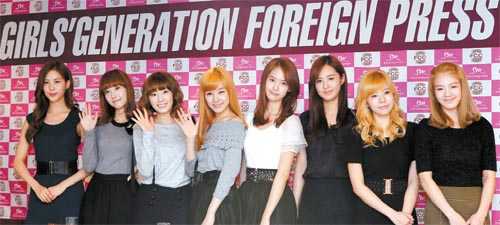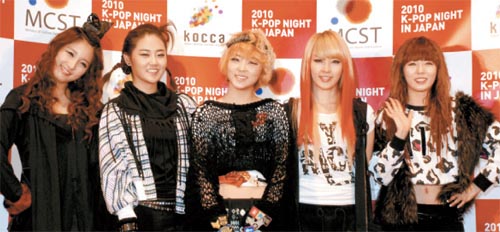In Japan, the Girls rule, big time

The members of Girls’ Generation, with the exception of Soo-young who was absent due to a slight injury sustained earlier that day, pose for the foreign press in Seoul, yesterday. From left: Seo-hyun, Jessica, Tae-yeon, Tiffany, Yoon-a, Yu-ri, Sunny and Hyo-yeon. [YONHAP]
With multicolored hair and immaculate makeup, eight members of Girls’ Generation were showered with camera flashes on Monday. Reporters were eager to hear from the girls who are now rocking the Japanese archipelago.
The Girls, who were giving a press conference at the Seoul Foreign Correspondents Club, had those gathered at the event whispering that they were the embodiment of “cute”: with their beaming smiles and their hugging of one another during the interview. The Girls are getting press coverage outside the country because their presence of just two months in Japan is at the forefront of what is now being called the “second Korean wave” - and they are enjoying every minute of it.
“We believe that we’ve been able to enter the foreign market because those who came before us did so well,” said leader Tae-yeon.
In the time since they debuted in Japan, the group’s popularity has risen - along with their chart rankings in the country. “Gee,” the group’s second single, shot to No. 1 on Japan’s highly-trusted Oricon daily singles chart. The group also made history for landing in the weekly “top 3 ranking” on the famous Japanese chart, something that hasn’t been done by a foreign female artist since 1980. The rankings are determined by artists’ record sales and popularity ratings gathered from its Web site.
“This is the happiest news we’ve had recently and we believe it has provided a great chance for us to try even harder,” Tae-yeon said of the group’s success.
The group is busy, and their schedule is not likely to let up anytime soon. They recently released a new single, “Hoot,” in Korea and they will be shuttling back and forth between the two countries to promote their music. In the past, artists releasing albums in Japan would usually stay in the country until it was time to release an album in Korea.
The girls see their busy schedule as an opportunity.
“You might think it would be difficult for us to make people understand us in a country that speaks a different language, but I think music speaks beyond countries. And we have a dream that we can deliver the energy we have to the public [in other countries.] Our energy, brightness ... our freshness?” Yoon-a said, laughing.
“And although we learned [Japanese] before we left, it’s an immense help for us to learn the language in our daily lives. I think that our Japanese debut is a great opportunity for us as celebrities,” Yu-ri chimed in.

4Minute members pose before a recent concert in Tokyo. From left: Nam Ji-hyun, Heo Ga-yoon, Jeon Ji-yoon, Kwon So-hyun and Kim Hyun-ah. [YONHAP]
The Japanese public, hit once before by a South Korean pop-culture wave with the nationwide hit, “Winter Sonata,” had middle-aged women swooning over the suave yet considerate male characters from the television drama. Profits from the drama have been measured at trillions of won since its launch in Japan in 2004.
Now, fresh-faced South Korean boy and girl groups are dominating the Japanese pop scene, and if the fans crying over Korean stars five years ago were women in their forties and fifties, now they’re girls in their teens and twenties. Experts believe this is because the younger generation has grown up raised by mothers affected by the first Korean wave, easing the younger generation into Korean food, language and music.
Another change in the new Korean wave is that the audience wants to hear Korean artists singing Korean songs - a shift from fan meetings where Korean celebrities would croon familiar, Japanese tunes to warm the fans’ hearts.
With young Japanese girls entranced by the flood of Korean pop groups, this has also affected what is worn on the street. Japanese pop culture magazines are eager to introduce the latest dance moves as well as make-up tips on how to look like the members of Kara and 4Minute, also recently introduced to the Japanese pop scene. By flipping through the pages, fans are easily informed about what the stars are wearing, what foods they like and the accessories they wear.
Weekly Japanese business magazine Nikkei Business published an article last Wednesday that said girl groups, like Girls’ Generation, would be the next leaders of South Korea’s economy after Samsung, crediting the groups’ outfits accentuating their legs, vocal abilities and familiar tunes.
“We can say that three elements came together to make this happen,” said SM Entertainment CEO Kim Young-min.
“First would be the girls’ abilities, second, the management company’s planning abilities and third, the change in media. All nine members of the group are incredibly capable and they try harder and prepare to improve their skills. I think these girls would do well in any part of the world. Also, the company has honed everything about the girls’ music and presentation to Asia’s taste, including their music and choreography.
“Last, the dynamics in the music industry has shifted. Before, stars would debut on smaller stages, but now you have a larger stage, that is the Internet.”
By Christine Kim [christine.kim@joongang.co.kr]










with the Korea JoongAng Daily
To write comments, please log in to one of the accounts.
Standards Board Policy (0/250자)